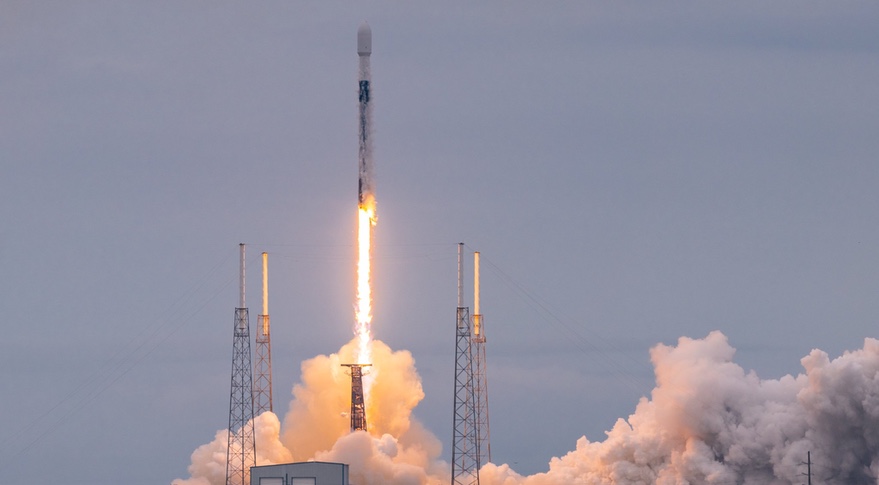WASHINGTON — SpaceX launched the fourth in its series of dedicated rideshare missions April 1, placing one relatively large satellite and dozens of smallsats into low Earth orbit.
The Falcon 9 lifted off from Space Launch Complex 40 at Cape Canaveral Space Force Station at 12:24 p.m. Eastern. SpaceX beat predictions of poor weather, with just a 30% chance of acceptable weather projected the day before liftoff. However, conditions improved in the hours leading up to liftoff to allow the launch to proceed.
The rocket’s booster landed on a droneship in the Caribbean near the Bahamas, because of the southerly trajectory taken the booster, at almost the exact time the upper stage reached orbit. That booster was on its seventh flight, having previously launched two NASA commercial crew missions, one commercial cargo mission, NASA’s IXPE astronomy satellite, the SXM-8 radio satellite and one set of Starlink satellites.
The upper stage initially entered a sun-synchronous orbit at 650 kilometers, deploying three satellites, then maneuvered to 500 kilometers using two additional burns of the upper stage engine before deploying the remaining payloads.
The mission, called Transporter-4 by SpaceX, was the fourth in a series of dedicated rideshare missions designed to carry large number of smallsats at relatively low prices. Unlike the previous three, which in some cases carried more than 100 satellites, SpaceX said there were only 40 satellites on this mission.
One reason for the smaller number was the size of one of the payloads, EnMAP. The satellite, whose name stands for Environmental Mapping and Analysis Program, weighed nearly 1,000 kilograms at launch. Built by OHB for the German space agency DLR, EnMAP carried a hyperspectral instrument for environmental studies.
“With the launch of EnMAP, Germany is making an indispensable contribution to climate protection. Its innovative hyperspectral sensor technology will really let us see Earth with different eyes,” Anna Christmann, federal government coordinator for German aerospace policy, said in a DLR statement. “With EnMAP, Germany is making an important contribution to European space technology for the benefit of our planet.”
It also marks the second time this year that a European government has turned to SpaceX, rather than Europe’s own Arianespace, to launch a satellite. A Falcon 9 launched Italy’s Cosmo-SkyMed Second Generation 2 radar imaging satellite Jan. 31. The Italian space agency ASI said it selected SpaceX to launch that satellite because of delays with the Vega C rocket.
The remaining payloads on Transporter-4 were smallsats more like the ones flown on the first three Transporter missions. Swarm, for example, flew 12 of its tiny SpaceBEE satellites, each a quarter of a single-unit cubesat in size, weeks after flying a set on an Astra Rocket 3.3 launch.
Satellogic flew five of its high-resolution imaging satellites on the mission. One of the five was a new “Mark 5” model with an improved multispectral camera featuring a resolution of 70 centimeters and 40% larger imaging swath.
HawkEye 360 flew three satellites to measure radio-frequency signals, joining nine others previously launched. The company said the new Cluster 4 satellites include enhanced antennas to better detect and geolocate terrestrial radio-frequency signals.
A French competitor, Unseenlabs, flew its BRO-7 satellite on the mission. The company said in a statement that it will launch another satellite, BRO-6, later this month on a Rocket Lab Electron, with a long-term goal of operating 20 satellites. “Expanding our satellite fleet is an important step to provide a better service for our clients from all around the world, and to give more power and value to our RF technology,” Clément Galic, chief executive of Unseenlabs, said in a statement.
Pixxel, an Indian startup planning a constellation of hyperspectral imaging satellites, launched its first “fully-fledged” satellite, called TD-2 or Shakuntala. The six-unit cubesat is designed to produce visible and infrared hyperspectral imagery at a resolution of 10 meters. Pixxel, which announced a $25 million Series A round March 28, expects to launch another satellite in the near future on an Indian PSLV.
Other customers Transporter-4 include PlanetiQ, which launches it GNOMES-3 satellite to collect GNSS radio occultation data for weather forecasting, and Lynk, which launched its Tower 01 satellite for direct-to-handset mobile connectivity services.
Transporter-4 was originally scheduled to carry a Sherpa tug from Spaceflight. However, SpaceX removed the Sherpa from the mission because of what it said were environmental factors affecting the spacecraft on the tug. SpaceX later notified companies that it would no longer work with Spaceflight on future rideshare missions.
